
"Speaking at Hot Chips this week, Don Soltis, a Xeon Processor Architect and Intel Fellow, touted a nearly 8:1 consolidation benefit for those upgrading from its six-year-old second-gen Xeon Scalable processors to its next-gen Clearwater Forest systems. Roughly 1,400 of the aging Xeon systems racks can be compressed into just 180 machines, he said. Of course, that's assuming that your workloads don't require AVX-512 vector acceleration. From what we understand, Clearwater Forest's 288 slimmed down efficiency cores (e-cores) won't support the instructions."
"As the name suggests, these cores share more in common with the e-cores found in Intel's consumer CPUs than its mainstream Granite Rapids Xeons. While it might seem like an odd choice to cram what are essentially a bunch of low-power mobile cores into a server part, for a lot of datacenter workloads, having a ton of good-enough cores beats having a handful of speedy ones, particularly where throughput is key. Webscalers and SaaS vendors take note."
Clearwater Forest is a next-generation Xeon aiming to vastly increase core counts using 288 slimmed-down efficiency cores and advanced packaging. Intel projects nearly 8:1 rack consolidation versus six-year-old second-gen Xeon Scalable systems, compressing roughly 1,400 racks into about 180 machines for suitable workloads. The e-cores will not support AVX-512 vector instructions, favoring throughput-oriented datacenter tasks where many efficient cores outperform fewer high-performance cores. The cores deliver about 17% more instructions per cycle through wider data paths. Up to 17 chiplets will be stitched via Foveros 3D and EMIB 2.5D packaging rather than reticle-sized dies.
#clearwater-forest #xeon-processors #chiplet-packaging-foverosemib #datacenter-consolidation #e-coresavx-512
Read at Theregister
Unable to calculate read time
Collection
[
|
...
]